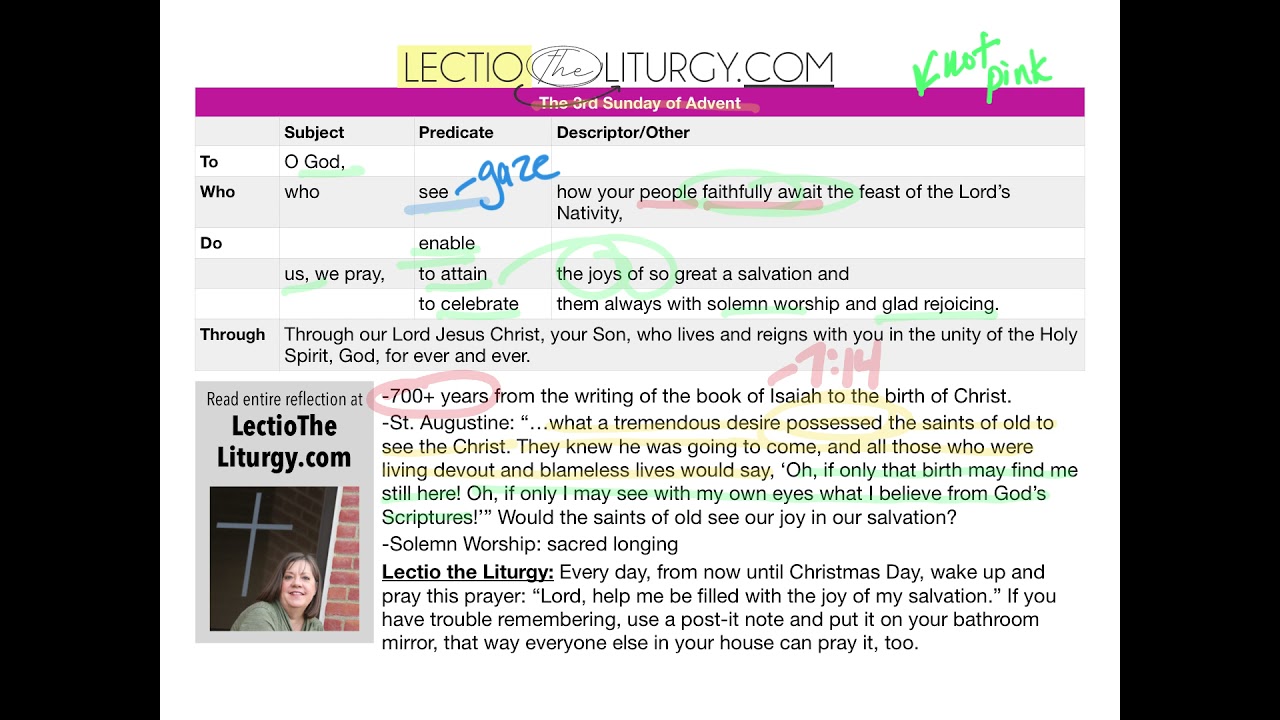Collect 3rd Sunday of Advent
This week we Lectio the Liturgy with the Collect for the 3rd Sunday of Advent. This is Gaudate Sunday. The name comes from the first word of the introit or entrance antiphon,“Gaudete.” In English, “rejoice.” “Rejoice in the Lord always, again I say, rejoice. Indeed, the Lord is near,” from Philippians 4:4-5. The rose candle is lit because rose is the color that represents joy. The scripture readings of the mass change as well, focusing us on the joyful expectation of the Savior.
O God, who see how your people faithfully await the feast of the Lord’s Nativity, enable us, we pray, to attain the joys of so great a salvation and to celebrate them always with solemn worship and glad rejoicing. Through our Lord Jesus Christ, your Son, who lives and reigns with you in the unity of the Holy Spirit, God, for ever and ever.
Let’s note that when God sees, it doesn’t mean that God is just watching and checking in. The word used for “see” in the Latin prayer is “conspicis.” It means to fix eyes upon. God is attentively watching our time of preparation.
I study each Collect for at least a week before I write. As I did dishes one evening this week, I was thinking about God’s people who faithfully await the feast of the Nativity. Somehow, the people I was thinking about, changed from us today to the people in Isaiah’s time. Isaiah, in 7:14 writes, “Therefore the Lord himself will give you this sign: the virgin shall be with child, and bear a son, and shall name him Immanuel.”
Our ancient brothers and sisters faithfully and expectantly waited. Over 700 years would pass between Isaiah’s prophecy and the birth of Jesus. St. Augustine wrote, “You must appreciate, brothers and sisters, what a tremendous desire possessed the saints of old to see the Christ. They knew he was going to come, and all those who were living devout and blameless lives would say, ‘Oh, if only that birth may find me still here! Oh, if only I may see with my own eyes what I believe from God’s Scriptures!’”
We see. We live in a time on the other side, more than 2,021 years after the birth of the Messiah, and I wondered if Isaiah came back today, would he find us rejoicing in the birth of Christ?
The heart of the prayer this week is that we attain, or we desire and come to possess, the joys of salvation. Advent is a time of expectant waiting but we need to keep focused on what we’re waiting for. While we shop and plan, bake and decorate, which are good things, we need to remember that we do them for one reason - because our Lord has been born and we have been given salvation.
This week, we’re also letting God know that we will celebrate the joys with solemn worship and glad rejoicing. Glad rejoicing is easy. There’s plenty of examples of glad rejoicing at the end of a Hallmark Christmas movie. We may rejoice when we hear our favorite Advent and Christmas songs. We rejoice when our loved ones walk in the door. I pray we rejoice when we receive Holy Communion at mass.
Solemn worship requires intention. Used here, solemn does not mean somber. In the Latin form of the prayer, the word used is “sollemnibus.” It means sacred.
Worship, or votis, in the Latin translation, is defined as a promise to a god, desire or longing.
I spent some time with the words solemn worship. Defined as sacred longing, it stirs up a desire for God. It may bring to you a desire for quiet time, your bible and a cup of tea. It may draw you to spend time in Adoration.
There are many people we will see this Advent and Christmas season who have this longing and may not even know that it’s Jesus that they desire. However, if we are filled with the joy of our salvation, they will recognize in us the true desire of their hearts.
Lectio the Liturgy: Every day, from now until Christmas Day, wake up and pray this prayer: “Lord, help me be filled with the joy of my salvation.” If you have trouble remembering, use a post-it note and put it on your bathroom mirror, that way everyone else in your house can pray it, too.
